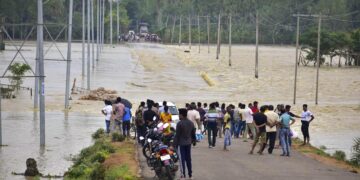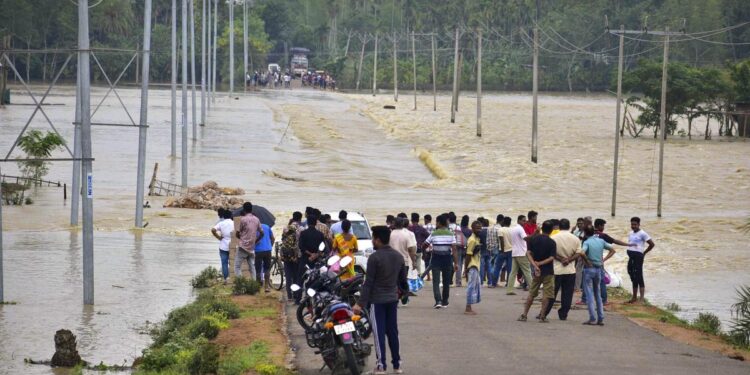At least 34 people have died in India’s northeast following devastating floods caused by heavy rains, with thousands displaced and rescue operations ongoing.
Heavy monsoon rains have triggered catastrophic floods and landslides across northeastern India, resulting in at least 34 confirmed deaths and displacing thousands. The Indian Meteorological Department (IMD) has issued warnings for continued heavy rainfall, exacerbating the already dire situation.

The floodwaters have submerged large areas in Assam, Arunachal Pradesh, and Sikkim. In Assam, over 515,000 people have been affected, with many seeking refuge in government-run relief camps. The Brahmaputra River, already swollen from upstream rains in Arunachal Pradesh, breached several embankments, inundating numerous villages.
In Sikkim, a flash flood caused by a cloudburst over Lhonak Lake led to the Teesta River overflowing, devastating towns along its path. The disaster has claimed at least 22 lives in Pakyong district alone, including 10 army personnel .
Rescue operations are underway, with the Indian Army and Air Force deploying personnel and equipment to assist affected regions. In Sikkim, the Indian Air Force has begun airlifting stranded tourists and residents from remote areas . However, persistent rainfall and challenging terrain have hindered rescue efforts.

In Assam, the situation remains critical, with many areas still submerged and roads impassable. The state government has issued alerts for potential landslides and flash floods, urging residents to remain vigilant .
Humanitarian Crisis and Government Response
The floods have led to significant displacement, with thousands of people seeking shelter in relief camps. The state governments, along with the central government, are coordinating efforts to provide food, medical aid, and other essential services to the affected populations.
Prime Minister #NarendraModi has reached out to the Chief Ministers of Assam, Sikkim, and Manipur, assuring them of full support from the central government in managing the crisis .
Environmental Impact
The floods have also had a devastating impact on the environment. In Assam’s Kaziranga National Park, home to the endangered one-horned rhinoceros, floodwaters have submerged nearly 80% of the park, leading to the death of several animals .
The region’s tea plantations have also been affected, with crops destroyed due to the floods, further impacting the local economy .
As the monsoon season continues, authorities are on high alert, monitoring river levels and weather patterns closely. The IMD has issued yellow alerts for several districts, cautioning residents about potential thunderstorms, lightning, and strong winds .
Read Also : Maharashtra ATS conducts searches in Thane in terror case; 12 detained















 Categories
Categories









